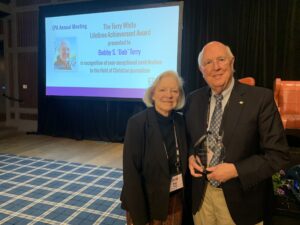
DALLAS (BP)–Trying to sort out all the issues in the controversy over “gender-neutral” or “gender-inclusive” Bible translation brings to mind the face-off in ancient pre-Socratic Greek philosophy between two giants of thought, Parmenides and Heraclitus.
In general, Parmenides emphasized the permanence of some things while Heraclitus put the accent on the fact that most things change over time.
In a sense, Wayne Grudem and D.A. Carson represent the same kind of face-off in the controversy that hit the New International Version Bible after its guardians began revising it with inclusive language, dropping the effort, however, after encountering a storm of protest.
The Bible translation controversy remains volatile two years after the NIV eruption. Last year’s developments included two books by respected publishing houses, Baker Book House and InterVarsity Press, and a highly attended session of the Evangelical Theological Society in November.
Both Grudem and Carson, well-respected scholars from Trinity Evangelical Divinity School in Illinois, disagree about how to handle gender-related language in Bible translation. Grudem is president of the Evangelical Theological Society and the Council on Biblical Manhood and Womanhood, an organization which advocates using “generic masculine” language in Bible translation when it occurs in the original texts — masculine terminology applying to both men and women. Carson, meanwhile, weighed in on the subject in the book, “The Inclusive Language Debate: A Plea for Realism” (Baker Book House and InterVarsity Press).
Grudem represents a more conservative approach that emphasizes the permanence of language or the reality it represents. Carson seems to stress the indisputable fact that language itself changes, and thus he takes a more moderate approach to translation.
Both men make points that seem well-taken, and the whole debate just gets more and more complicated.
In all fairness, neither side can make an absolute case that maintains consistency across the board. For example, translating from the original biblical languages, in actual practice, involves compromises in favor of the conservative approach at times and, at other times, in favor of the moderate approach.
In other words, both sides use the other’s translation style at times. The conservative side uses some “inclusive” language while the moderate side sometimes can’t avoid “generic masculine” language.
But it seems at this point that the wise way would be to err on the conservative side and favor Grudem’s approach, even if the jury may still be out on this particular case. Being overly cautious in a situation as important as translating the Word of God makes more sense than making what may prove to be misjudgments in the light of future historical analysis — especially in the current climate of much debate about change in language related to gender.
Several overarching issues need to be sorted out and clarified in the translation controversy.
First, there seems to be disagreement between the two sides on translation and its relationship to interpretation and application. Although translation, interpretation and application are probably inseparably related, they can and should be distinguished, a distinction which seems to be more consistently made by the conservative side.
Everyone knows that almost all translation involves some degree of interpretation. What scholars disagree about is the degree of interpretation and/or application necessary in going about the task of Bible translation.
For example, much of the controversy revolves around figurative versus non-figurative language. Generic masculine language, or one gender referring to both sexes, is one particular kind of figurative language; inclusive language, which neutrally refers to both sexes, is non-figurative. When there is figurative language, such as generic “man” or “he” used for both sexes in the original text, the conservative side believes translation should also be figurative when possible. Thus generic “man” figure of speech is retained in translation, as it is used in the original Greek or Hebrew. The moderate view, meanwhile, allows for more interpretation and application, most of the time interpreting the figure of speech non-figuratively: “person” for “man” or “they” for “he,” for example. This latter view accommodates those who consider generic “man” to be sexist.
This “translation-interpretation” distinction can also be seen as a difference of “formal” translation philosophy versus “functional” translation theory. The former is also known as “literal” while the latter view is sometimes called “dynamic.” The more conservative view focuses on the form of the original in addition to the meaning and so translates figuratively if possible when a figure of speech appears. The more moderate view is that meaning alone is important and so translation should be non-figurative, at least as far as generic “man,” “he,” and “brother” are concerned.
Yet another way of looking at the disagreement is to distinguish between author/text and audience. The conservative side is emphasizing the author and the text more than the audience while the moderate approach is to keep the audience in mind foremost and hence to focus on the meaning for the reader over the writer.
Another overarching issue: a difference in the understanding of revelation and inspiration. If one’s view is more conservative, holding that inspiration extends to the very words of Scripture, then the form will be more important than if inspiration extends only to thoughts, in which case the meaning alone is important and translation can be done more freely as in the dynamic approach, which is a thought-for-thought philosophy of translation. If God inspired only the thoughts of the writers of Scripture, the thinking goes, then there is more freedom to not worry about following the form as closely as those who take a “literal” approach in translating. Of course, among most evangelicals, including Grudem and Carson, there is probably no disagreement about revelation and inspiration since they both are conservative theologically and therefore hold to the traditional, orthodox view that both the form and the meaning are inspired.
Finally, and perhaps most important, there seems to be much confusion stemming from the distinction between language and culture.
The moderate side seems to think that language and culture can be separated into two different issues, such that feminism in the culture isn’t really the culprit in the push for inclusive language. But the conservatives see feminism as a major influence in the movement to eliminate generic masculine language.
Furthermore, conservatives see the trends to change language as a negative thing, something that can be addressed and possibly reversed. This is a prescriptive view of the relation between language and culture, which means there is something people can do about it rather than stand by and simply accept the inevitable.
The moderate side, meanwhile, sees the relationship between language and culture as descriptive, which means that language change is inevitable and something that shouldn’t be fought, even if feminism did have something to do with the current changes. The focus in this view is more on communication regardless of the political implications.
The conservative side is sensitive to what it has described as illegitimate cultural intrusions into the task of Bible translation. If generic masculine language is understood, despite not being liked by some, it should still be used in translation to maintain accuracy. One of the major points to be made by the conservative side in regard to generic “man” has to do with something called “semantic male marking” or “male overtones.” When the original text seems to indicate that a male human being is standing as the representative of a group of human beings in general, the translation of that “representative generic” should retain masculinity so as to not downplay male spiritual leadership, which is seen as essential to the meaning of Scripture from the conservative point of view. Since that meaning of male leadership was in the original culture and language, it should be retained despite any objections by modern culture to such language.
In a paper presented at the Evangelical Theological Society’s annual meeting last November, E. Ray Clendenen, of the Broadman & Holman publishing arm of LifeWay Christian Resources of the Southern Baptist Convention, documented the rise of radical feminism and how it has influenced language in general throughout society to the point that this social and political engineering has affected Bible translation more and more in recent years. “This linguistic engineering was driven by an ideology opposed to what I believe to be the biblical view of manhood and womanhood,” Clendenen wrote. “We are not dealing with an attack on orthodox Christology or soteriology, but we are dealing with an attack on orthodox anthropology,” or the nature and function of individuals in society. The way Clendenen sees it, “We are in the midst of a crisis of masculinity, which will result in a crisis of femininity, if it has not already.”
Sometimes generic “man” can be avoided without changing much, but generic “he” is more difficult to get around without a feeling that the text is being changed unnecessarily. Avoiding generic “he” involves changing person and/or number, which seems too high a price to pay when dealing with something as important and crucial as the Bible, which is a much different situation than an English research paper, for example.
Clendenen pointed out one way that gender can be changed without changing person or number with examples from both the Old and New Testaments: “If the RSV’s ‘A man’s steps are ordered by the LORD’ (Prov. 20:24) or NIV’s ‘What goes into a man’s mouth does not make him unclean’ (Matt. 15:11) are felt to miscommunicate general statements as masculine ones, this can be corrected by using such words as ‘one,’ ‘anyone,’ and ‘someone’ rather than by changing the person or number.”
Translating an ancient document is quite a different matter than writing new material for publication today. Better, in dealing with Scripture, to err on the conservative side for the time being.
Couric is a freelance writer in Fort Worth, Texas, and a Ph.D. candidate at the University of Texas at Arlington who holds a master’s degree in biblical languages from Dallas Baptist University and a master’s in linguistics from UTA.














